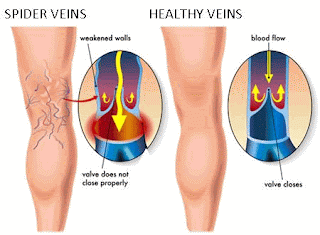Let’s start with the basics - what actually causes the varicose veins? Possibly by now we all know this; veins usually have one-way valves, which typically open up as soon as the blood travel upwards and also closes down to prevent the blood from leaking down.
In certain cases, when the valves of the deep vein system fails to close tightly, blood leaks back (medically speaking; this has been termed as ‘reflux’) while setting the stage for vein trouble. Yes, this may also lead to painful varicose veins.
Let us understand things in detail – the valves inside the leg veins are responsible for carrying the blood straight up to the heart. As already briefed, when these valves find it difficult to function properly, they substantiate the blood in the vein itself. This in turn leads to improper flow. This result in inflammation of the vein with blood that gets stocked up there - named as varicose veins.
Those that are smaller in appearance and occur on the surface of the skin are medically termed as spider veins. A lot has been talked about the unsightly varicose veins still a lot of mystery and myth shrouds them.
Here are a few important points to ease your mind!
#Varicose vein Myth 1: Crossing your legs can cause varicose veins: It is an absolute wrong notion. Crossing your veins can never cause varicose veins, nor does wearing high heels may cause them. Basically; varicose veins are caused by prolonged sitting or prolonged standing. Other contributory factors which may cause varicose veins are obesity, lack of exercise, smoking and hormonal birth control.
#Varicose vein Myth 2: Varicose veins are just a cosmetic problem: The fact is; spider veins or varicose veins are not just cosmetic problems but they also cause pain, swelling and general discomfort. According to the experts varicose veins can also be the warning signs of long-term health risks such as blood clots, leg swelling, deep vein thrombosis, poor blood circulation etc.
#Varicose vein Myth 3: It can be genetic: Well; this has some amount of fact associated with it. You can inherit the tendency from one parent or from both sides. It can even skip a generation.
#Varicose vein Myth 4: There is no exact cause of varicose veins: Although the exact cause of spider veins is still shrouded in mystery still research has clearly proved that heredity, trauma, pregnancy, aging, heredity, sun damage and hormonal influences are considered as some of the potent factors.
#Varicose vein Myth 5: Men can never have varicose veins: This is also a wrong notion. Although statistical records reveal that 70 to 80% of patients treated for spider and varicose veins are women, however experts confirm that men too suffer from spider veins and varicose
Several Varicose Vein treatment procedures are available in order to relieve varicose veins. For instance; often wearing stockings or saying yes to a few lifestyle changes can help in relieving the pain. However for long time
The first method of treatment is laser. Here, the doctor typically aims the beam over the spider veins. This makes the veins to coagulate and shrink.
Sclerotherapy is yet another popular vein removal treatment that has been developed to treat unsightly spider and varicose veins. In this procedure the doctor injects a special solution into the vein to collapse it. Over time, the body absorbs the vein naturally.
Here are a few pointers to mull over before saying yes to the varicose vein treatment in Huntington Beach.
Point 1: If in case the patient is pregnant, it is advisable to wait for around six weeks post-delivery prior considering varicose vein surgery because I n most of the cases the varicose veins that occur during pregnancy will fade away.
Point 2: Varicose vein surgery is typically reserved for people who either don’t get relief from the lifestyle changes, or from the home care treatment
Point 3: People for cosmetic reasons may want to try sclerotherapy or laser treatment in order to make the veins less prominent.
Most of the surgical procedures are performed on an outpatient basis. We never get tired of saying that with any surgery, benefits and risks exist hence all these should be clearly discussed with the specialist involved.
Good luck!

